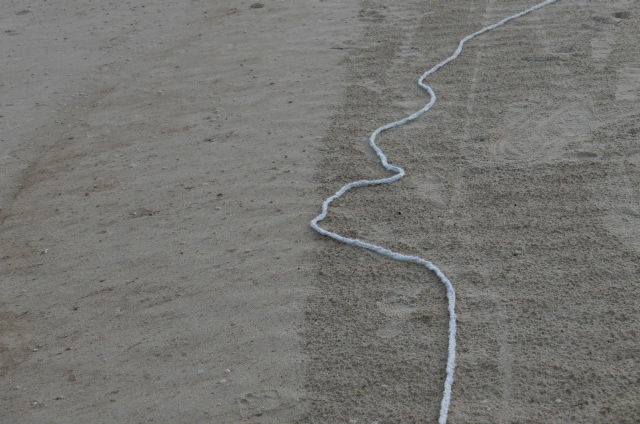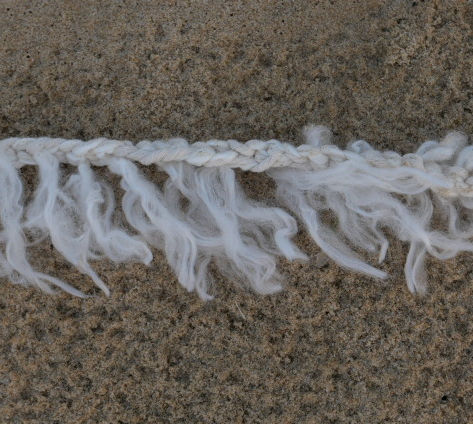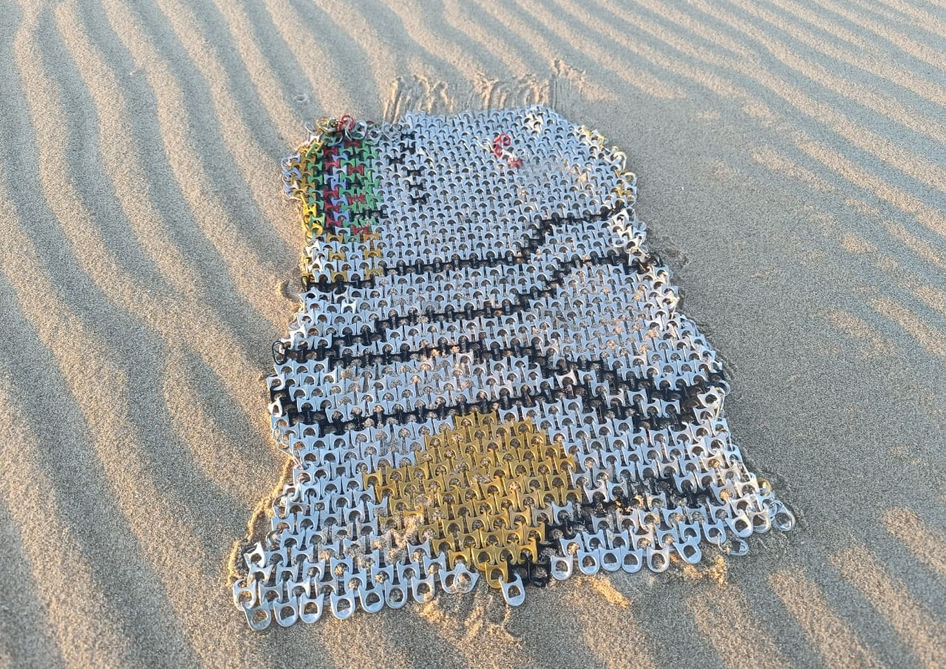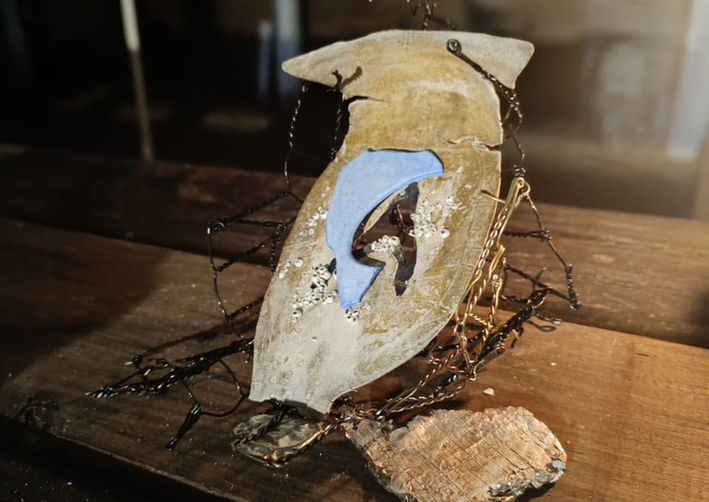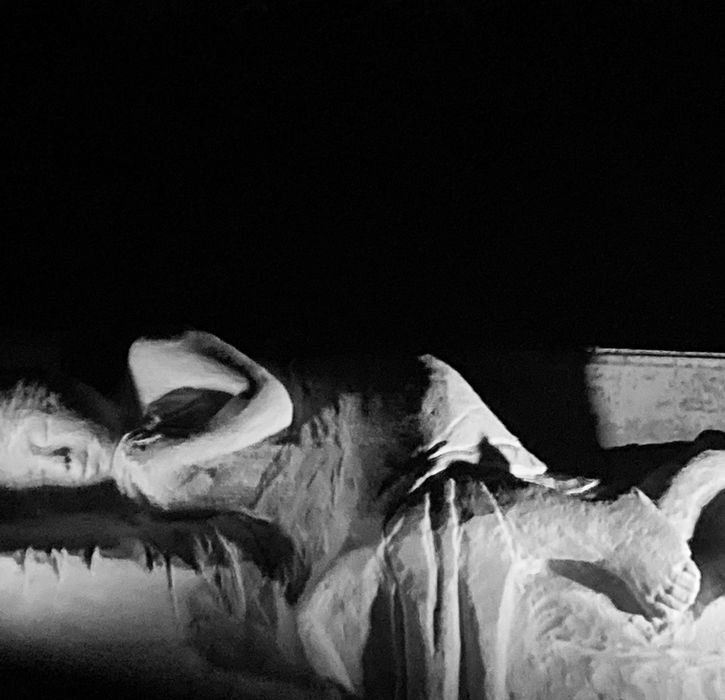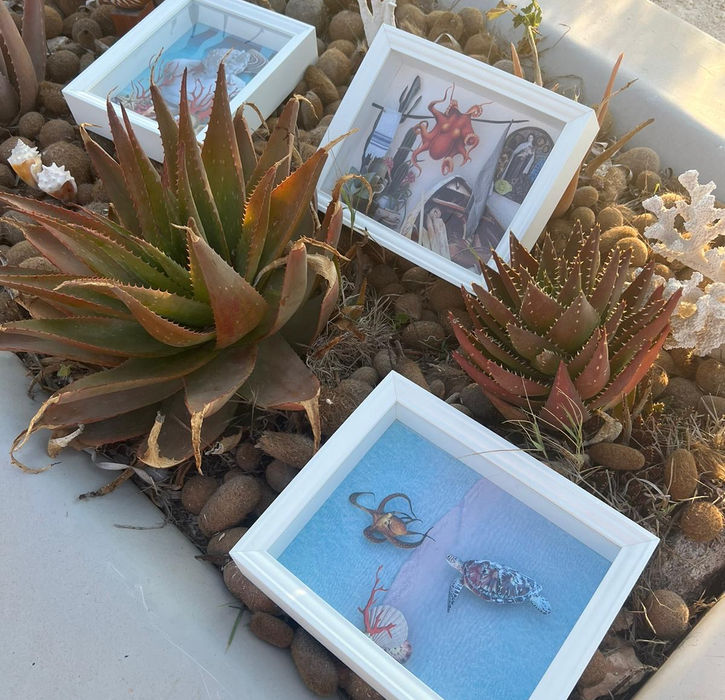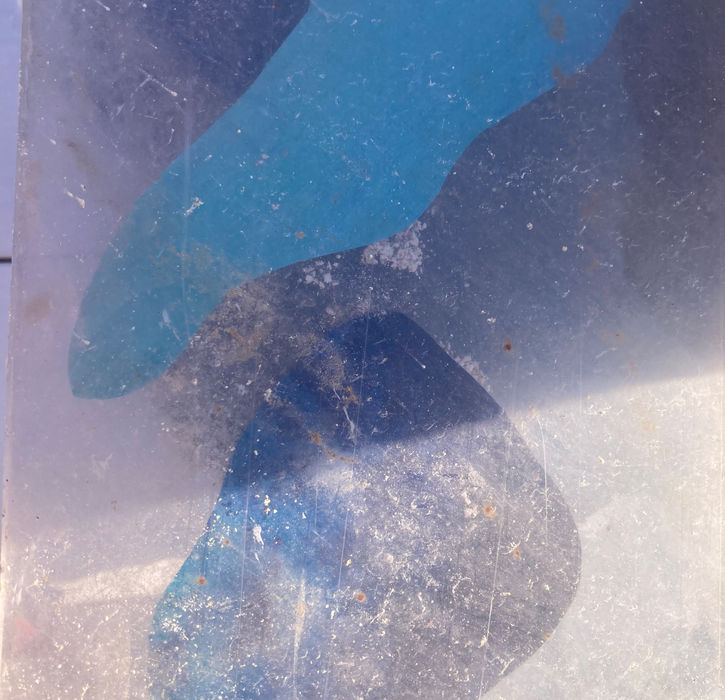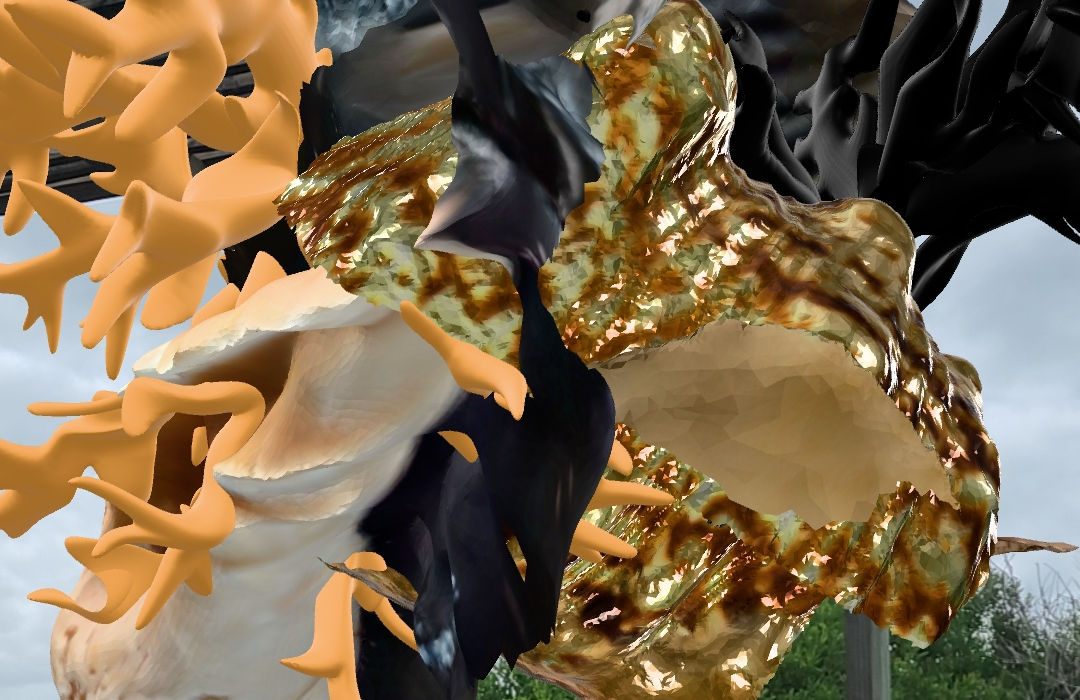SOL-O: The Madness of the Ocean
An Invitation to Confront the Infinite February 2025
The ocean has always captivated humanity: a symbol of discovery, mystery, and wonder. In Sol-O, the artists don’t merely observe the ocean; they engage in a dialogue with it. Here, the ocean is not just a backdrop, but a silent companion that helps the artists explore what connects and separates them from the wild, the primal, and the elemental.
Solitude in Sol-O is not isolation, but an intentional space where distractions fall away, leaving only the essential. To be alone before such vastness offers no escape from thoughts and emotions; rather, it opens a space for artists to encounter their inner selves. Here, time flows with the rhythm of the waves and the wind, allowing each artist to forge a deeper connection with their inner life and creativity.
-
During the days of the residency, the sea acted as a constant call, never fading, inviting one to draw closer to the shore. On those coasts lay everything the tide brings in and the sand buries.
Each morning, I would walk north, and in the afternoons, I’d head south, shifting the sand in search of remnants, discovering hidden gleams among the particles of rock and minerals—because one never knows what might arrive, nor how long it has taken to get there. I carried two bags: a small one for collected treasures and a larger one for trash. In the midst of an idyllic landscape, the trash camouflages itself, hiding as if it didn’t exist. My commitment to the place didn’t allow me to ignore the obvious. I cleared the beaches of bottles and shoe soles, of formless plastics and darkened, eroded styrofoam. I became a gatherer—a pretext to be there and to make use of whatever I had at hand. A way to insist that making was still possible.
After completing the walks, I would clean the items from the smaller bag—the treasure one—and then assemble some of them with other objects gathered in Buenos Aires: wire from muselets and bits of tempered phone glass. With these materials, I created small objects—mutant organisms that needed prosthetics to survive, to rebuild themselves, to coexist with their surroundings. It was a way of imagining new fictions, recreating the past through the present, as if it were somehow possible to return to a state before the social pact.
While the sea never rested, it kept tossing up materials, reminding us that society is always in motion. And the sea, murmuring in the background, whispered its infinite circularity to us.
One night, by candlelight and as the culmination of the experience, I laid out the pieces I had made on a wooden table. Beside them, an aerial sculpture: a hanging mesh made of aluminum tabs that I had brought from Buenos Aires and assembled during my free time. It was a topographic fabric containing remnants discarded by society—together forming a kind of chainmail or exoskeleton.
To conclude the residency, together with Natalia, coordinator of Oceanic Scene, we photographed some of the objects I had created, with the intent to continue a body of work I’ve been developing since 2022: Catalog of Mythological Prostheses for Organisms in Mutation. It’s a work in progress, a catalog of photographic images—direct shots—featuring objects connected or supported by prosthetics crafted from muselets, set against gradient backgrounds mimicking the aesthetic of orthopedic product catalogs. These images show collected items forming small-format sculptures with joints defined by equal conditions, where a mineral fragment, a piece of plastic, or a shard of glass constitute the same detritus, manifesting as persistent remnants. Everything subsists as something different from what it was at the beginning, yet still traceable, sometimes unaltered. I collect fragments—meticulously and selectively—of what society discards, and with them, I create small-format sculptures. Like specimens from diverse ecosystems, through the elements that compose them, they develop prostheses and orthotics, mutating and adapting to forced coexistences and communities.
(written by Emilia De Las Carreras)


PROJECT FOR THE RESIDENCY
Conceptually, I begin with drawing as a line: a moving point traced by my movement, and weaving as a record of this journey becomes a drawing of my walk. I conceive my weavings as narratives of paths; where threads are joined, tied, and cut to give shape to the finished work.
The piece I propose for this residency is a record of the movement of sea waves and their traces on the sand. The project consists of creating a crocheted piece — a continuous line with a twisted spiral pattern as a symbolic record of the drawing left by the sea on the sand.
Weaving the sea foam is to create a narrative, an indexical drawing of the experience by the sea, the sway, the rhythm of the waves. The weaving becomes a kind of text: a continuous, steady text, with pauses.
A constant dialogue, back and forth, giving and receiving. The thread enters and exits, comes and goes. This finished piece, when exhibited, will be presented as an installation organically invading the exhibition space — like foam spilling through the room. The dimensions of the textile piece will depend on the material generated during the residency.
Marisol Maza. (Ciudad de México, 1979)
She has participated in various exhibitions in cities across Mexico, Argentina, Spain, Portugal, Venezuela, Cuba, Bolivia, Ecuador, and Italy. Highlights include De mar y de tierra, solo show The Good Life Jauja (Querétaro, Mexico 2024), XXII Biennial of Contemporary Art in Santa Cruz de la Sierra (Bolivia, 2023), Retratos, Territorios at Galería Cuba (Mexico City, 2022), Retratos at Instituto de Periodismo José Martí (Havana, Cuba 2016), Desapariciones at V&S Gallery (Mexico City, 2016), A Quemarropa at Parking Gallery (Alicante) and Espacio Trapecio (Madrid, 2015), Nanofestival Buenos Aires (Argentina, 2013), Se Renta o Se Vende at MUCA, CU (Mexico City), INTIMATE SPACE (Vienna, 2011), 7th Photography Biennial Puebla de los Ángeles (2009), “Id” at Galería José María Velasco (2009), Postres at Centro Cultural La Balsa (Bogotá, Colombia 2008), and LATINOLATINO (Naples, Italy, 2008).


PROJECT FOR THE RESIDENCY
Catalogue of Mythological Prostheses for Mutating Organisms is a work in progress — a catalog of photographic images, direct shots, where objects are connected or supported by prostheses developed by “muselets” against gradient backgrounds, imitating the distinctive design of orthopedic product catalogs. These include collections of objects forming small-format sculptures with joints marked by equality of conditions, where a mineral fragment, a plastic remnant, or a piece of glass make up the same debris that manifests as a persistent residue. Everything subsists as something different from what it originally was, yet with still traceable, sometimes unaltered, moments. I meticulously and selectively collect fragments discarded by society and use them to create small-format sculptures. Like specimens from diverse ecosystems, through their components they develop prostheses and orthopedics, mutating and adapting to forced coexistences and communities. The result of these images aims to form a catalog on a topographical and everyday investigation of a city, at a specific time and place: Buenos Aires, Argentina (2020–present).
During the Escena Oceánica residency, I have brought this experience of being an "entomologist of discards" to another geography to delve into the collective unconscious revealed in the remnants of a specific area and time — such as Oceania del Polonio, Uruguay — to then transform them into sculptures and photograph them.
Emilia De Las Carreras (Buenos Aires, 1989)
Emilia de las Carreras is a visual artist trained through various workshops and programs, including ArtistasxArtistas and the Artists Program at the Torcuato Di Tella University. She has exhibited in group shows in Argentina and internationally (Mexico, Ecuador), and held solo exhibitions at Gachi Prieto, No Lugar (Quito), Proyecto A, Quimera Galería, and Galería Grasa. She received the First Prize at Proyecto A (2017) and the Revelation Prize from Fundación Andreani (2022). She currently teaches in the “Painting in the Hospital” program, is a member of G.E.A.Y.S (Art and Health Study Group), and is represented by Galería Grasa.

July 16, 7:00 PM.
I accept the invitation sent to me by Stefano Rallo and head to the Calamoni. On the left, in the Puntazza area, the gate to Stefano's property is open. I stop before entering.
How long has it been since I last set foot in this area? I look around, recognizing the rocks and the shallow water that welcomed me as a child, but I no longer see the spot where I used to tirelessly fish with a line. I enter the property. And in no time, I feel as if I’ve stepped back in time: an unassuming house, benches, a vast piece of land recently planted with trees that have become rare, like fig trees.
Aromatic herbs, dirt paths, fruit trees, succulents emerging from massive rocky outcrops—everything just as it was when I used to spend my summers at the Calamoni. Stefano welcomes us warmly and introduces us to his young artist friends: Nicolas, Gabriela, and Stefano—the first two are South American, the latter Italian.
Their works are scattered throughout the vast surrounding land, but without pretension, almost shyly. Dozens of calcarenite objects of various shapes, yet ready to recompose themselves into the perfection of a circle; harmonious but sorrowful sculptures of a humanity too often swallowed by the sea; collages of the most beautiful things the sea offers us, which we too often mistreat.
Everything is very beautiful, without showiness, placed simply in that vast space that seemed to be waiting for the presence of a world of harmonious thought, yet dense with meanings that completed it.
Thank you, Stefano, for this beautiful artistic, emotional, and "nostalgic" experience.
Maria Guccione
Tuf-O OCEANO BIANCO | July 2024


Gabriela Lopez
Gabriela López, a prominent plastic artist from Gral Pico, La Pampa, graduated with a degree in Fine Arts in 1998, earning the title of Full Professor of Drawing and Sculpture. In 2014, she began focusing on her personal work, participating in several group exhibitions. She won the “Grand Prize of Honor” at the Salón Patagonico de Artes Plásticas in the sculpture section and received an honorable mention at the La Pampa National Sculpture Exhibition. In 2015, she held her first solo exhibitions in La Pampa and Buenos Aires and debuted at the National Hall of Plastic Arts at the Palais de Glace. Her works are in collections in Switzerland, Italy, Canada, Brazil, Colombia, Peru, Chile, Uruguay, and Argentina. Gabriela López continues to live and work in her hometown.
Work Plan for Tuf-O Resident 2024 - THE CHILD'S DREAM / FAVIGNANA
My projects are always connected to childhood, they have to do with children—the children who live with us and those who dwell within us.
How much of the child we once were do we still carry with us?
"Ever since I was a child, I would sleep on the white tuff. I would let myself get scratched while I hid in the quarries, and it was like diving into the sea, a white sea. Where the sun would burn my dreams..."
"The child's dream" is inspired by this text by Stefano Rallo and by my encounter with Favignana, its geographical and human landscape.
Then came the encounter with an abandoned little boat covered in shrubs, and the realization of how many children, alone or with their parents, carry their dreams across the sea to reach the shores of Sicily, and the sea cradles this dream, like a lullaby that all too often turns into silence in its depths.
Work Plan for Tuf-O Resident 2024 - AQUARIUM/ FAVIGNANA
Elements washed ashore by the sea are reinterpreted and transformed into decorative objects inspired by the underwater world.
Three plexiglass panels, held together by an old rope from a fishing vessel, become three aquariums for fish, coral, and collage anemones.
The song of the sea is sung by a chorus of nautiluses, corals, and shells mounted on ancient wooden bases found on the beach.
The notes of the same song settle on a triptych of three-dimensional collage works that tell underwater stories of ancient busts hidden on the seabed and of an octopus fleeing the advances of a turtle.

Le Sauvage Dècorateur
Founded in 2015, Le Sauvage Décorateur is inspired by the adventures of Robinson Crusoe. Defoe's hero builds a home on the island using wooden planks from the shipwreck and natural elements like palm trees for a roof and coconuts as dishes. Robinson, an Englishman, creates a colonial-style dwelling far from Europe.
Le Sauvage Décorateur’s philosophy blends Western certainties with the vibrant colors of the tropics, where flora and fauna invade urban spaces. Travel photos, vintage magazine illustrations, and flea market finds become creative patchworks and eclectic patterns for home décor.
Work Plan for Tuf-O Resident 2024 - CERCHIO / FAVIGNANA
The hospitality of Favignana and my constant dialogue with tuff stone created a turning point in my exploration of the circle in relation to others, be it the environment or people.
This installation stems from my ongoing research on the circle and its form. The circle represents perfection—it has no beginning or end, no orientation or direction. It symbolizes harmony, time, eternity, balance, archetypes, and magic. The circle embodies the sun, the moon, the planets, the cosmos. Its iconography and circular movement hold an infinite array of universal meanings and references.
The aim of this new installation is to attempt to "explode" the closed form of the circle—a child's first drawing, a symbol of individual unity—by expanding it into the surrounding space. "Circle" is an installation composed of 34 individual pieces made from tuff, an iconic and valuable stone for the island of Favignana. These pieces are arranged in a way that does not directly recall the shape of a circle, yet they originate from the "breaking" of a circle into multiple parts. Together, they would reconstruct the original circle, but here they are arranged to conform to a new circular form.
I approached this project intuitively, yet guided by a precise mental "design," which I sought to translate through harmonic coordinates. The challenge of using such a fragile material for studying the circle led me to deconstruct the form itself, turning it into a metaphor for our fragility as human beings.

Nicolas Denino
Nicolas Denino began his career in fashion and design across various European cities before settling in Milan in 2014, where he grew closer to the art world. After a stay in New York, he left fashion to focus entirely on painting. He now resides in Milan, having opened a new studio in 2021.
His art reflects on contemporary society's struggles with forming lasting connections, a theme influenced by Zygmunt Bauman. Blue circles, a recurring motif in his work, symbolize living beings that meet but never merge, representing this relational tension. Denino creates his signature blue using lapis lazuli and is currently exploring the circle form in design and environmental projects.
Go to meet the ocean.
Move to meet a desire, an idea, a question. In the moment before displacement, separation. I come from the river. I always heard that all rivers go to the sea.
But the rivers seem younger to me with their apparent calm, their banks full of life and camalotes.
The ocean, with its rhythmic breathing, and its magnetic sway, hypnotized me every day. The Escena Oceánica residence seemed to me the ideal place for this profound encounter: it is the
ocean breathing and spitting out the remains of worlds, and you. Every day I crossed the dune and its little forest to go breathe it, talk to it and touch it.
I learned that microscopic marine plants, phytoplankton, and other algae produce more than half of the oxygen we breathe.
We were already connected by air. Its strength felt so imposing that I remained cautious (I would never have imagined that it would not I was going to encourage swimming very deep).
The ocean's breathing is wild, and that's what I loved the most. In Oceanía del Polonio the beach is mysterious and desolate.
The mystery is accentuated by the remains of a ship that sank just off the slope of the home. A stick and some other piece of iron that appear very close to the shore, beaten by the waves
infinitely. A familiar landscape appeared in my previous works, as if I had intuited or dreamed about it a lot.
before arriving.
That was a sign that responded to what I proposed for the residency. If there is no linearity, there is no first breath because there is no last breath either.
There are disturbances and displacements and ruptures and encounters that emerge and become detached.
reconfiguring reality. The ghosts of the beach also came to participate in the intertwining.
Since then we all (the ghosts, the ocean and I) share information and those memories
They persist in meeting. Every day is different, the weather changes rapidly.
On some windy days the sand mixes with the humidity of the air and everything turns an orange light.
The landscape becomes more ghostly, disappears and you can only see a few meters around.
Other days the air becomes clear and the ocean blue, greenish. And many other days the grays dominate, which are the particular vibration of Oceania and make the
horizon seem more infinite. Since my proposal was to experiment materially, and no ritual is in vain, I also took its water for 21 days. I asked him to share material, I made it part of my body and brought it home. The materiality of the idea I was going to pursue felt salty, and transparent. The ocean lives in me."
Laura Benech - Escena Oceanica, February 2024
PRIMER ALIENTO - FEBRUARY 2024

Argentine visual artist. Her works explore the digitalization of environments and codification of the landscape.
She experiments with different (im)materialities on the interweaving of ecologies digital in the Capitalocene.
She creates analog and hybrid structures digital that propose fictitious speculations on the limits of science, fixed binary metaphors and the romanticization of nature.
Work Plan for Art Resident 2024 - FIRST BREATH / ESCENA OCEANICA
During my residency at Escena Oceánica, I used photogrammetry, color registration, and landscape video to create an augmented reality artwork reflecting the unique elements of the Polonio Ocean. Open to the environment, I merged with the sea's rhythm through daily meditation. My project explores layers of perception and reality, depicting the ocean's unfathomable mystery and its timeless rhythm. Augmented reality technology adds a "magical" quality to my digital sculpture, which represents the eternal movement of the sea and the parallels found in all landscapes. These landscapes, devoid of humans but marked by civilization, evoke echoes of a possible future.

Laura Benech
Work Plan for Art Resident 2024 - FIRST BREATH / ESCENA OCEANICA
My experience focuses on landscape exploration and of its infinite possibilities, not only as a source of inspiration visual, but also as raw material. I use natural materials like wood, clay and stone to create my sculptures. During my stay at Escena Oceanica I had the opportunity to delve into the area and work with the wood of fallen trees and with clay extracted from the beach. I firmly believe that the use of indigenous materials gives my works a unique character, closely linked to the landscape in which they are born.
My goal is to achieve a balance between what nature offers and my artistic intervention.

Gabriela Lopez
Gabriela López, a prominent plastic artist from Gral Pico, La Pampa, graduated with a degree in Fine Arts in 1998, earning the title of Full Professor of Drawing and Sculpture. In 2014, she began focusing on her personal work, participating in several group exhibitions. She won the “Grand Prize of Honor” at the Salón Patagonico de Artes Plásticas in the sculpture section and received an honorable mention at the La Pampa National Sculpture Exhibition. In 2015, she held her first solo exhibitions in La Pampa and Buenos Aires and debuted at the National Hall of Plastic Arts at the Palais de Glace. Her works are in collections in Switzerland, Italy, Canada, Brazil, Colombia, Peru, Chile, Uruguay, and Argentina. Gabriela López continues to live and work in her hometown.






















